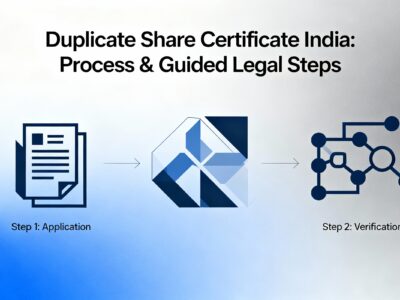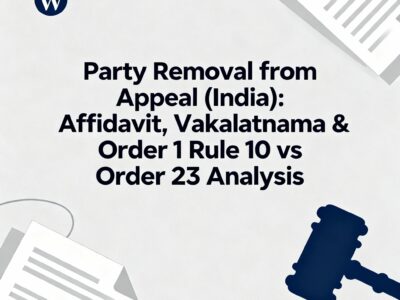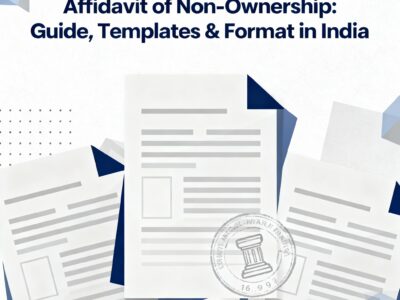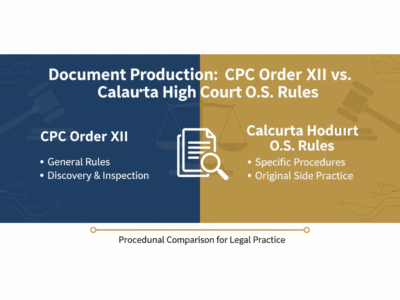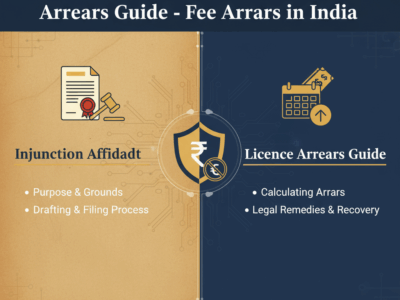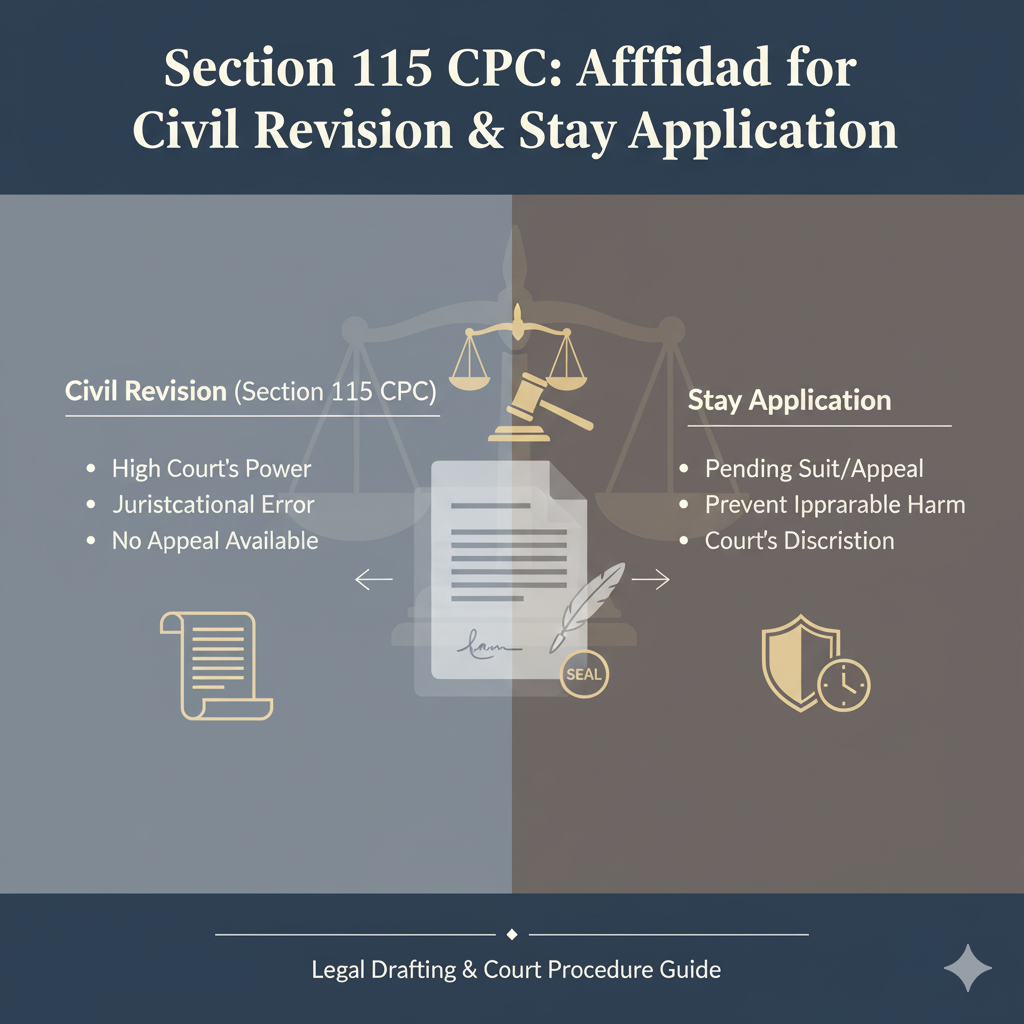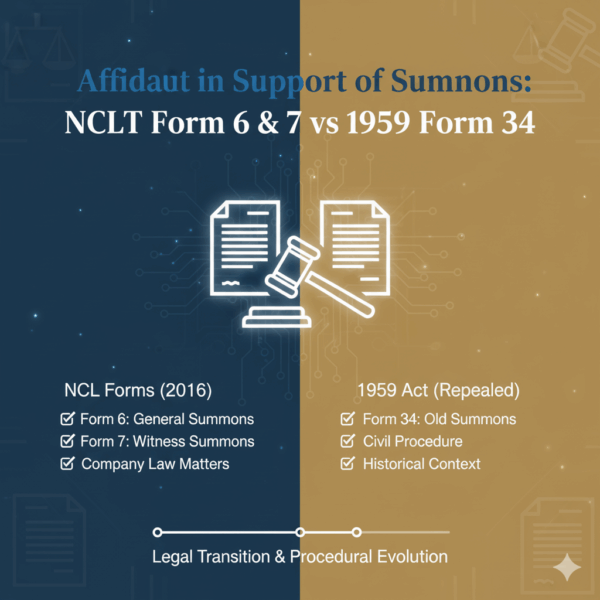Plaintiffs in an Order 37 summary suit often need to secure their claim to ensure the final decree is valuable. A common procedural mistake is confusing two key legal paths: seeking security under Order 37, Rule 3 as a condition for the defendant’s ‘leave to defend’, and applying for attachment before judgment under Order 38, Rule 5, based on the defendant’s conduct.
This strategic guide clarifies the critical differences, explains the Supreme Court’s ‘leave to defend’ test, and provides affidavit templates for both plaintiff and defendant strategies under the Code of Civil Procedure.
Securing Claims in Summary Suits: A Strategic Analysis
Understanding Order 37 and Order 38 of the Code of Civil Procedure, 1908
Updated: October 2025
A Common Procedural Mistake
Plaintiffs in summary suits (Order 37) often need to secure their claim before the case ends. They want to ensure the defendant has assets to pay the final decree. However, many litigants make a mistake: they confuse the two main legal paths for doing this.
The provided sample affidavit, for example, mixes them up. It uses facts for one rule (the defendant selling assets) to ask for a remedy under a different rule (the defendant has a weak defence). This can make the application fail. This guide clarifies the two distinct procedures:
- Order 37, Rule 3: Security as a condition for the defendant’s ‘leave to defend’.
- Order 38, Rule 5: Attachment before judgment, based on the defendant’s conduct.
Quick Guide: Find Your Path
Use these filters to see the information most relevant to you.
Infographic: The Two Paths to Security
Path 1: Order 37, Rule 3
Based on the Defendant’s Defence
Path 2: Order 38, Rule 5
Based on the Defendant’s Conduct
The Order 37 Summary Suit Timeline
A summary suit is fast. Missing a deadline by one day can cost you the case. Both parties must be vigilant.
-
1
Suit Filed & Summons Issued
Plaintiff files the suit. Court issues a ‘Summons for Appearance’.
-
2
Defendant Enters Appearance
Defendant has 10 days from receiving the summons to file an appearance. If not, plaintiff gets an immediate decree.
-
3
Plaintiff Serves Summons for Judgment
After appearance, Plaintiff serves a ‘Summons for Judgment’, supported by an affidavit verifying the claim.
-
4
Defendant Applies for Leave to Defend
Defendant has 10 days from this summons to file an application (with affidavit) for ‘Leave to Defend’. This is the most important step for the defendant.
-
5
Court Hearing on Leave
The Court hears arguments and decides whether to grant leave (unconditional or conditional) or refuse leave (decree for plaintiff).
How Courts Decide: The ‘Leave to Defend’ Test
At the hearing (Step 5), the judge assesses the defendant’s affidavit based on principles set by the Supreme Court. The quality of the defence determines the outcome.
The Guiding Precedent: Mechelec Engineers
The chart above is based on the principles laid down by the Supreme Court of India in the landmark case of Mechelec Engineers & Manufacturers v. Basic Equipment Corporation (1976). This judgment provides the definitive framework for how courts must handle applications for leave to defend.
The court established the following categories:
- If the defendant shows a substantial defence (a good, arguable case), the court must grant unconditional leave to defend.
- If the defendant raises a triable issue (a point that needs to be argued), even if not substantial, the court should grant unconditional leave.
- If the defence is “plausible but improbable” (e.g., seems unlikely but could be true), the court may grant conditional leave (e.g., deposit the suit amount).
- If the defence is not bona fide or frivolous, the court should refuse leave and grant an immediate decree for the plaintiff.
- If the defendant admits part of the claim, leave shall not be granted unless the admitted part is deposited in court.
Defendant Strategy: Crafting the “Leave to Defend” Affidavit
For the defendant, the “Leave to Defend” affidavit is the entire case. A weak affidavit guarantees a loss. The primary goal is to show the court that there is a genuine dispute that requires a full trial.
1. Do Not Make a “Bare Denial”
Simply saying “I deny the claim” is useless. This is considered a “sham” defence. You must provide specific facts and evidence to support your denial. For example, instead of “The goods were defective,” state, “The goods (Batch No. 123) were received on [Date] and a notice of defect was sent via email on [Date], a copy of which is attached.”
2. Raise a “Triable Issue”
A triable issue is a question of fact or law that the court cannot decide without hearing evidence. Examples include:
- The signature on the cheque is forged.
- The goods were never delivered.
- There was a separate agreement for payment in instalments.
- The amount has already been paid (with proof).
3. Attach All Possible Proof
Attach every email, letter, bank statement, delivery receipt, or other document that supports your defence. The affidavit should be a self-contained summary of your entire case, not just a procedural document.
Plaintiff Strategy: Common Pitfalls to Avoid
While Order 37 is a powerful tool for plaintiffs, simple mistakes can derail the case. The burden is on the plaintiff to follow the procedure perfectly.
- Using the Wrong Affidavit: This is the most common error, as seen in the sample document. Do not confuse the arguments. If you want security based on the *weakness of the defence*, you argue this under Order 37, Rule 3(6)(b) in your reply. If you want attachment based on *defendant’s conduct*, you file a separate IA under Order 38, Rule 5. Mixing them weakens both arguments.
- Vague Order 38 Allegations: For an Order 38 attachment, simply stating “I fear the defendant will sell his property” is not enough. You must provide specific evidence. For example, “The defendant has listed his factory premises for sale on [Website]” or “The defendant has been seen removing machinery at night.”
- Defective Plaint: Ensure your suit qualifies for Order 37. Is the claim based *only* on a written instrument? Is the amount a “liquidated” (fixed) sum? If not, the court may convert the suit to an ordinary suit, and you lose the summary procedure advantage.
The Order 38 Remedy: Attachment Before Judgment
This is a separate, powerful tool. It is not tied to the ‘leave to defend’ hearing. A plaintiff can file this application (IA) at any stage, even day one. Its purpose is to stop a defendant from disposing of assets to make the decree useless.
The Two-Part Test for Order 38
To succeed, the plaintiff’s affidavit must convince the court of two things:
- The plaintiff has a strong, *prima facie* case.
- The defendant is actively trying to sell, remove, or dispose of property with the specific intent to obstruct or delay the execution of any future decree.
Vague allegations are not enough. You must provide specific details about the assets and the defendant’s actions.
The Exception: Condonation of Delay (Rule 3(7))
What happens if the defendant misses the 10-day deadline to enter an appearance or file for leave to defend? While the rules are strict, they are not completely inflexible. Order 37, Rule 3(7) allows the court to excuse the delay if the defendant can show “sufficient cause.”
What is “Sufficient Cause”?
This is decided on a case-by-case basis. The defendant must file a separate application for condonation of delay explaining exactly why they were late. Merely being busy or negligent is usually not enough.
- Valid examples: A medical emergency, a death in the family, a natural disaster, or a delay in receiving the summons.
- Weak examples: “I forgot,” “My lawyer was busy,” or “I was out of town for work.”
The court will only grant this if it is convinced the defendant was genuinely prevented from acting and has a strong, bona fide defence.
Comparison: Order 37 vs. Order 38
| Feature | Order 37, Rule 3 (Security) | Order 38, Rule 5 (Attachment) |
|---|---|---|
| Legal Basis | Quality of defendant’s defence (e.g., “plausible but improbable”). | Mala fide conduct of defendant (e.g., “intent to obstruct or delay”). |
| When to File | Argued at the ‘Leave to Defend’ hearing (Step 5). | Any stage of the suit, even at the beginning. |
| Document Filed | Plaintiff’s Reply Affidavit to the defendant’s application. | A new Interlocutory Application (IA) with a supporting affidavit. |
| Primary Goal | To get a security deposit as a *condition* for allowing the defendant to defend. | To physically *attach* the defendant’s assets or get security to prevent their disposal. |
| Evidence Needed | Show the defendant’s affidavit is weak, contradictory, or not in good faith. | Show specific facts of asset disposal, removal, or intent to defraud creditors. |
| Court Order | “Leave to defend is granted, subject to depositing Rs. X.” | “The defendant is directed to furnish security for Rs. X, failing which the property [Y] shall be attached.” |
A Smart Strategy: Using Both Rules
A plaintiff can use both procedures. This is a very effective approach.
File O.38 Immediately
If you have evidence the defendant is selling stock, file an IA under Order 38, Rule 5, on day one. Ask for an *ex-parte* (immediate) order to freeze the assets.
Proceed with O.37 Timeline
The main suit continues. The defendant will eventually file for ‘Leave to Defend’ (Step 4).
Use O.38 as Evidence
At the ‘Leave to Defend’ hearing, use your pending O.38 application as evidence. Argue: “The defendant’s defence is not in good faith; they are actively trying to hide assets, as shown in our O.38 IA.”
The Result
This taints the defendant’s credibility. The judge is now much more likely to find the defence “doubtful” and order a full security deposit under Order 37, Rule 3.
Template Formats
These are basic templates for guidance. Always consult a legal professional for your specific case.
Key Averments for Order 38, Rule 5 Affidavit
IN THE COURT OF...
I.A. NO. _____ OF 20__
IN
O.S. NO. _____ OF 20__
...Applicant / Plaintiff
VS
...Respondents / Defendants
AFFIDAVIT SUPPORTING APPLICATION UNDER ORDER XXXVIII, RULE 5
I, [Name], son of [...], aged [...], resident of [...], do solemnly affirm:
1. That I am the Plaintiff, am conversant with the facts, and am competent...
2. That the present suit is filed for recovery of Rs. ______ based on [e.g., dishonoured cheque / written contract]...
3. That the Plaintiff has a prima facie case and is likely to succeed...
4. That I have come to know from dependable sources that the Defendant, with intent to obstruct the execution of any decree, has taken steps to dispose of his assets.
5. That on [Date], I learned that the Defendant is [e.g., actively negotiating to sell his stock-in-trade / removing machinery from his premises].
6. That the Defendant's intent is to siphon off the proceeds and render himself judgment-proof, thereby defeating his creditors.
7. That the Defendant does not have any other known assets from which the decree can be satisfied.
8. That if the Defendant is not restrained, the Plaintiff will suffer irreparable loss and any decree obtained will be infructuous.
9. It is prayed that this Court direct the Defendant to furnish security for the suit amount, failing which the properties... be attached.
DEPONENT
VERIFICATION
...
Frequently Asked Questions
It is an expedited procedure for recovering specific types of debts. It applies only to claims based on written instruments like cheques, promissory notes, bills of exchange, or written contracts for a fixed sum. The goal is a faster judgment by limiting the defendant’s right to a full trial.
Yes. An application for attachment before judgment under Order 38, Rule 5, can be filed at any stage of the suit, from the moment the plaint is filed until the judgment is passed. Its timing is based on when you get credible information about the defendant’s intent to dispose of assets.
The plaintiff is entitled to an immediate *ex-parte* decree. The allegations in the plaint are deemed to be admitted. This is why the initial 10-day deadline is so strict for the defendant.
No. A security deposit under Order 37 is usually a cash deposit or bank guarantee paid *into the court* as a condition for the defendant to be allowed to defend. The money is held by the court. An attachment under Order 38 “freezes” the defendant’s specific property (like a house or inventory), preventing them from selling it. The property stays with the defendant but cannot be legally transferred.


